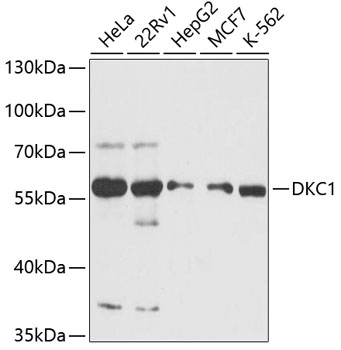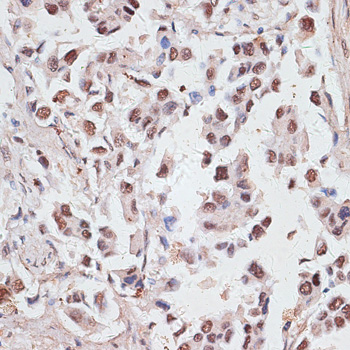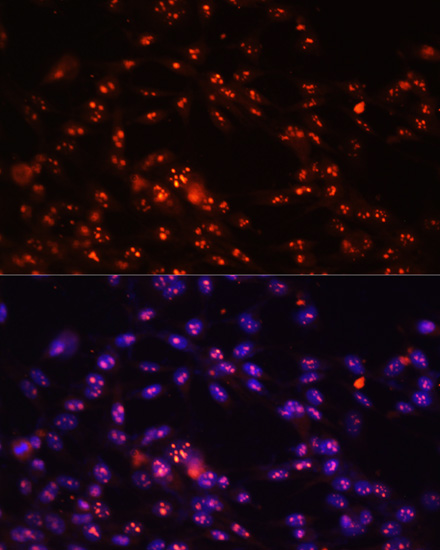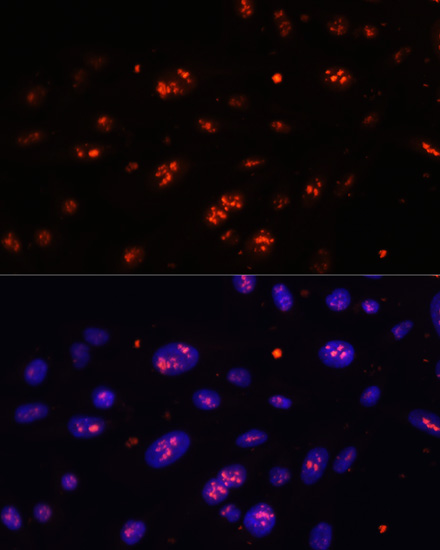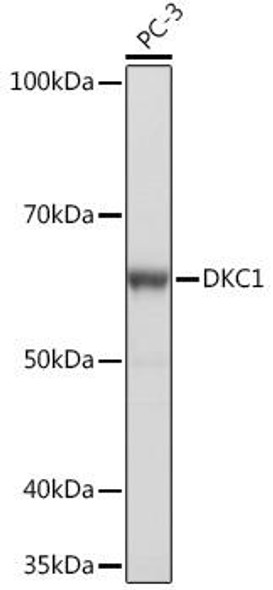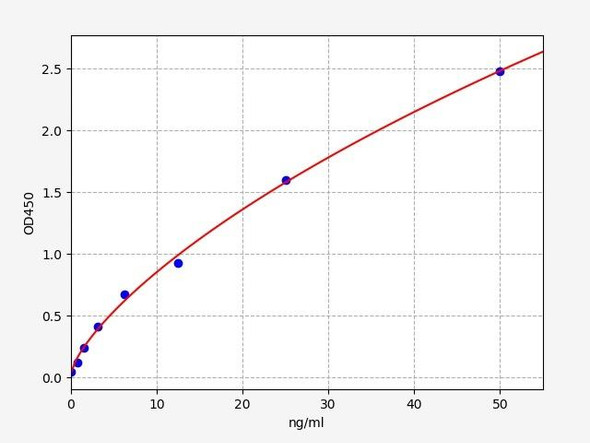Cell Biology Antibodies 3
Anti-DKC1 Antibody (CAB12914)
- SKU:
- CAB12914
- Product Type:
- Antibody
- Reactivity:
- Human
- Reactivity:
- Mouse
- Host Species:
- Rabbit
- Isotype:
- IgG
- Antibody Type:
- Polyclonal Antibody
- Research Area:
- Cell Biology
Description
| Antibody Name: | Anti-DKC1 Antibody |
| Antibody SKU: | CAB12914 |
| Antibody Size: | 20uL, 50uL, 100uL |
| Application: | WB IHC IF |
| Reactivity: | Human, Mouse |
| Host Species: | Rabbit |
| Immunogen: | Recombinant fusion protein containing a sequence corresponding to amino acids 1-180 of human DKC1 (NP_001354.1). |
| Application: | WB IHC IF |
| Recommended Dilution: | WB 1:500 - 1:2000 IHC 1:50 - 1:100 IF 1:50 - 1:100 |
| Reactivity: | Human, Mouse |
| Positive Samples: | HeLa, 22Rv1, HepG2, MCF7, K-562 |
| Immunogen: | Recombinant fusion protein containing a sequence corresponding to amino acids 1-180 of human DKC1 (NP_001354.1). |
| Purification Method: | Affinity purification |
| Storage Buffer: | Store at -20'C. Avoid freeze / thaw cycles. Buffer: PBS with 0.02% sodium azide, 50% glycerol, pH7.3. |
| Isotype: | IgG |
| Sequence: | MADA EVII LPKK HKKK KERK SLPE EDVA EIQH AEEF LIKP ESKV AKLD TSQW PLLL KNFD KLNV RTTH YTPL ACGS NPLK REIG DYIR TGFI NLDK PSNP SSHE VVAW IRRI LRVE KTGH SGTL DPKV TGCL IVCI ERAT RLVK SQQS AGKE YVGI VRLH NAIE GGTQ LSRA LETL TGAL |
| Gene ID: | 1736 |
| Uniprot: | O60832 |
| Cellular Location: | Cajal body, Cytoplasm, Nucleus, nucleolus |
| Calculated MW: | 47kDa/57kDa |
| Observed MW: | 57kDa |
| Synonyms: | DKC1, CBF5, DKC, DKCX, NAP57, NOLA4, XAP101 |
| Background: | This gene functions in two distinct complexes. It plays an active role in telomerase stabilization and maintenance, as well as recognition of snoRNAs containing H/ACA sequences which provides stability during biogenesis and assembly into H/ACA small nucleolar RNA ribonucleoproteins (snoRNPs). This gene is highly conserved and widely expressed, and may play additional roles in nucleo-cytoplasmic shuttling, DNA damage response, and cell adhesion. Mutations have been associated with X-linked dyskeratosis congenita. Alternative splicing results in multiple transcript variants. |
| UniProt Protein Function: | dyskerin: Isoform 1: Required for ribosome biogenesis and telomere maintenance. Probable catalytic subunit of H/ACA small nucleolar ribonucleoprotein (H/ACA snoRNP) complex, which catalyzes pseudouridylation of rRNA. This involves the isomerization of uridine such that the ribose is subsequently attached to C5, instead of the normal N1. Each rRNA can contain up to 100 pseudouridine ('psi') residues, which may serve to stabilize the conformation of rRNAs. Also required for correct processing or intranuclear trafficking of TERC, the RNA component of the telomerase reverse transcriptase (TERT) holoenzyme. Defects in DKC1 are a cause of dyskeratosis congenita X- linked recessive (XDKC). XDKC is a rare, progressive bone marrow failure syndrome characterized by the triad of reticulated skin hyperpigmentation, nail dystrophy, and mucosal leukoplakia. Early mortality is often associated with bone marrow failure, infections, fatal pulmonary complications, or malignancy. Defects in DKC1 are the cause of Hoyeraal-Hreidarsson syndrome (HHS). HHS is a multisystem disorder affecting males and is characterized by aplastic anemia, immunodeficiency, microcephaly, cerebellar hypoplasia, and growth retardation. Belongs to the pseudouridine synthase TruB family. 2 isoforms of the human protein are produced by alternative splicing. |
| UniProt Protein Details: | Protein type:Isomerase; EC 5.4.99.-; Nucleolus; Lyase; RNA-binding; RNA processing Chromosomal Location of Human Ortholog: Xq28 Cellular Component: cytoplasm; nucleolus; nucleoplasm; nucleus; telomerase holoenzyme complex Molecular Function:protein binding; pseudouridine synthase activity; RNA binding; telomerase activity Biological Process: box H/ACA snoRNA 3'-end processing; cell proliferation; positive regulation of telomerase activity; positive regulation of telomere maintenance via telomerase; RNA processing; rRNA processing; rRNA pseudouridine synthesis; snRNA pseudouridine synthesis; telomere maintenance; telomere maintenance via telomerase Disease: Dyskeratosis Congenita, X-linked |
| NCBI Summary: | This gene functions in two distinct complexes. It plays an active role in telomerase stabilization and maintenance, as well as recognition of snoRNAs containing H/ACA sequences which provides stability during biogenesis and assembly into H/ACA small nucleolar RNA ribonucleoproteins (snoRNPs). This gene is highly conserved and widely expressed, and may play additional roles in nucleo-cytoplasmic shuttling, DNA damage response, and cell adhesion. Mutations have been associated with X-linked dyskeratosis congenita. Alternative splicing results in multiple transcript variants. [provided by RefSeq, Jan 2014] |
| UniProt Code: | O60832 |
| NCBI GenInfo Identifier: | 3913488 |
| NCBI Gene ID: | 1736 |
| NCBI Accession: | O60832.3 |
| UniProt Secondary Accession: | O60832,O43845, Q96G67, Q9Y505, F5BSB3, |
| UniProt Related Accession: | O60832 |
| Molecular Weight: | 47,603 Da |
| NCBI Full Name: | H/ACA ribonucleoprotein complex subunit 4 |
| NCBI Synonym Full Names: | dyskerin pseudouridine synthase 1 |
| NCBI Official Symbol: | DKC1 |
| NCBI Official Synonym Symbols: | DKC; CBF5; DKCX; NAP57; NOLA4; XAP101 |
| NCBI Protein Information: | H/ACA ribonucleoprotein complex subunit 4 |
| UniProt Protein Name: | H/ACA ribonucleoprotein complex subunit 4 |
| UniProt Synonym Protein Names: | CBF5 homolog; Dyskerin; Nopp140-associated protein of 57 kDa; Nucleolar protein NAP57; Nucleolar protein family A member 4; snoRNP protein DKC1 |
| UniProt Gene Name: | DKC1 |
| UniProt Entry Name: | DKC1_HUMAN |
View AllClose


